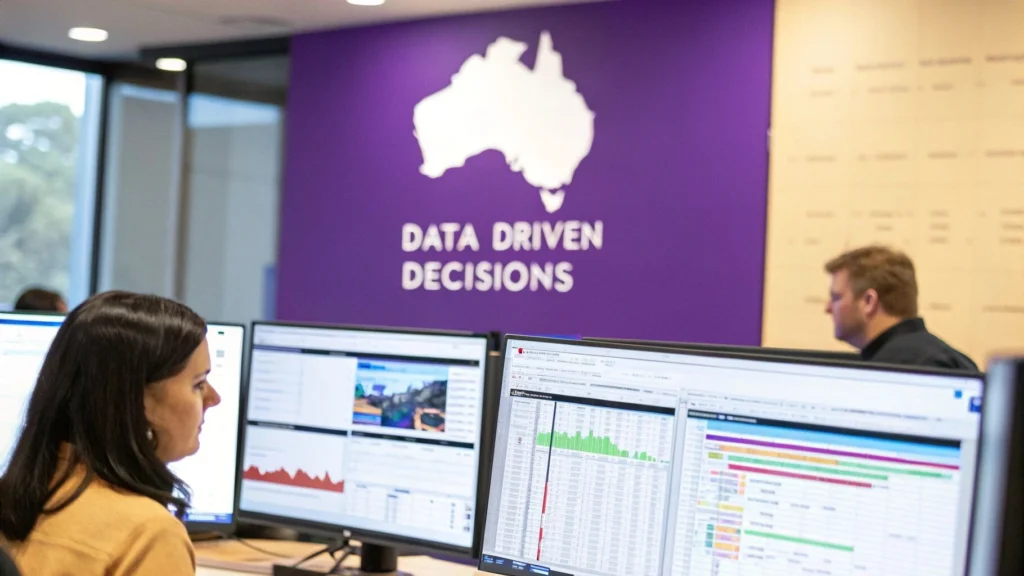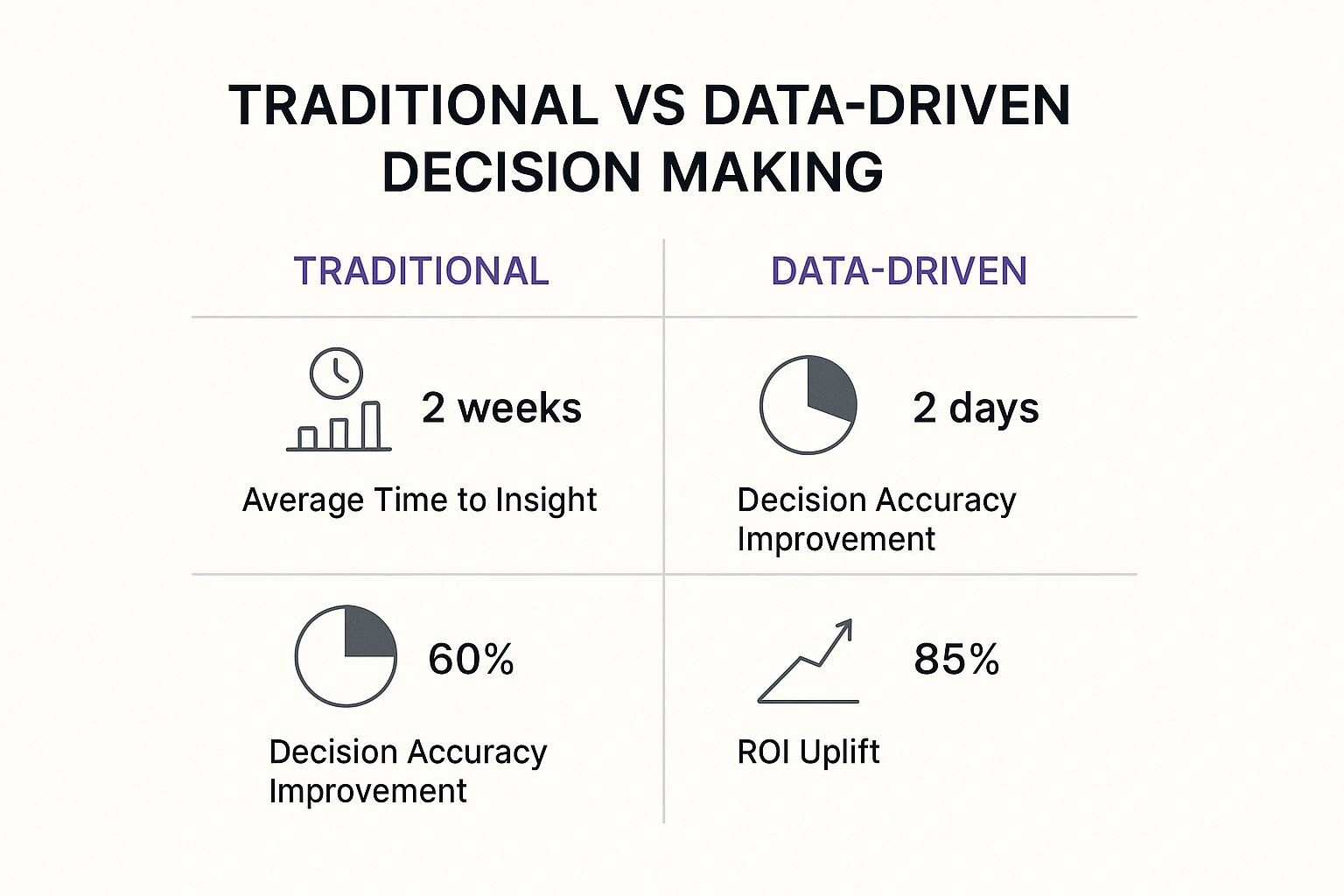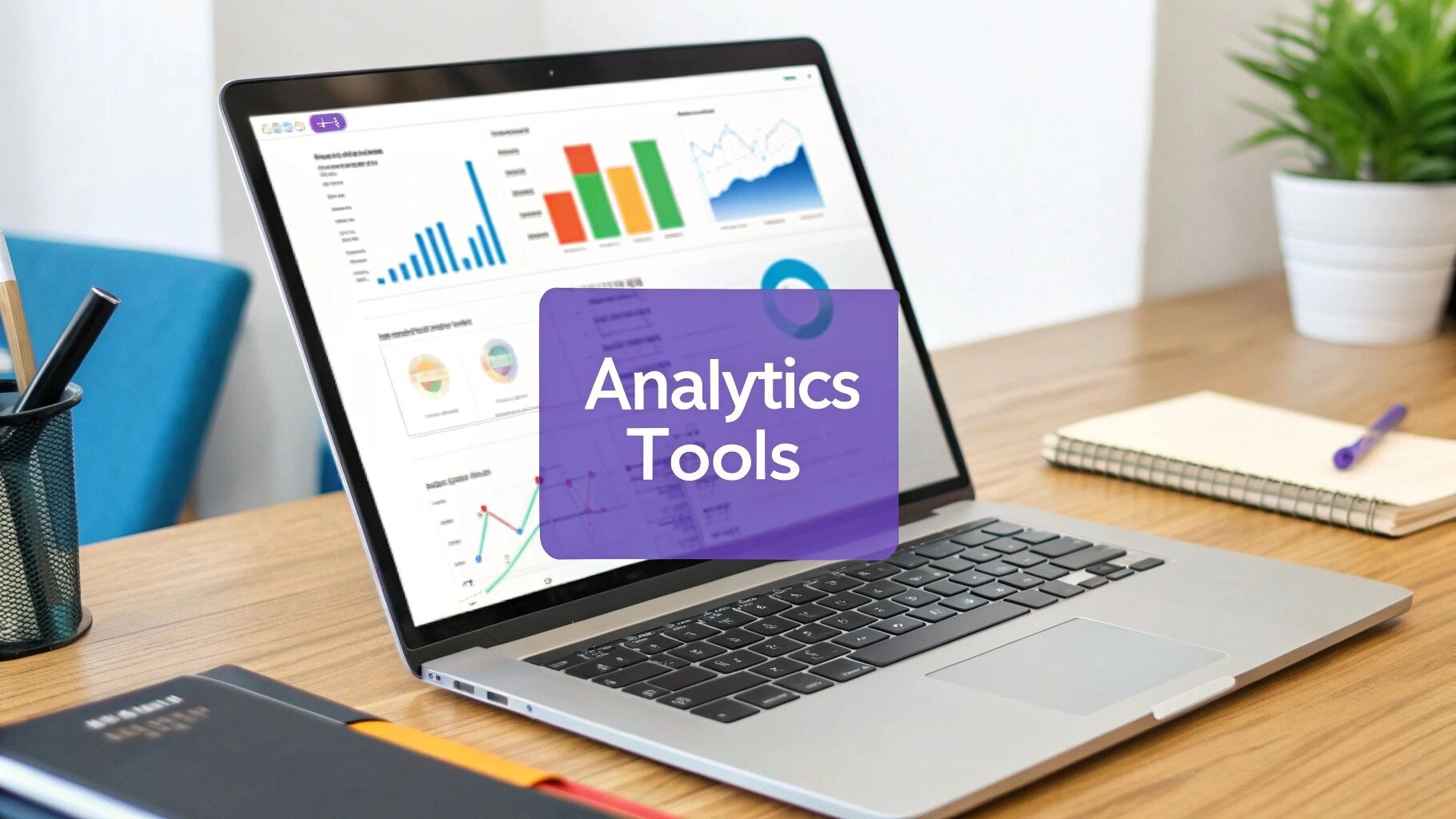Mastering Data Driven Decision Making in Australia
Unlock growth with data driven decision making. This guide shows Australian businesses how to leverage data for smarter strategies and a competitive edge.

Data-driven decision-making is, at its core, the practice of making strategic business choices based on hard evidence. It’s about systematically collecting, analysing, and interpreting verifiable data to guide your actions, rather than relying solely on intuition or old habits.
This means every decision, big or small, becomes objective, measurable, and much more likely to succeed.
Understanding the Core of Data-Driven Decisions
Think of it this way: a seasoned ship’s captain could try to navigate treacherous waters using only their experience and a gut feeling about the tides. Or, they could use precise navigational charts, real-time weather data, and sonar readings to plot the safest, most efficient course. Data-driven decision-making is the business equivalent of using those advanced tools. It’s about swapping guesswork for a clear path forward.
This evidence-based approach provides a solid foundation for every action you take. It isn’t just abstract corporate jargon; it’s a practical framework that any Australian business can adopt when they’re ready to value evidence over assumptions.
From Gut Feelings to Factual Insights
For a long time, many business leaders prided themselves on their “gut instinct.” And while experience is certainly valuable, it’s often coloured by personal bias, past experiences that may no longer be relevant, and incomplete information. A data-driven approach systematically dismantles these potential blind spots, leading to more consistent and reliable outcomes.
The fundamental question shifts from, “What do we think will work?” to “What does the data prove is working?”
This change in mindset has a ripple effect across the entire organisation:
- Marketing: Campaigns get refined based on cold, hard performance metrics, not just what a creative director likes the look of.
- Operations: Supply chains are adjusted using real-time demand signals, rather than relying on historical forecasts that might be out of date.
- Product Development: New features are built and prioritised based on actual user engagement data, not just what someone in a meeting thinks is a good idea.
Gut Instinct vs Data-Driven Decisions
To really grasp the difference, let’s compare the two approaches side-by-side. The shift is from relying on internal feelings to trusting external, objective evidence.
| Decision Aspect | Intuition-Based Approach (The ‘Gut Feeling’) | Data-Driven Approach (The ‘Evidence’) |
|---|---|---|
| Foundation | Personal experience, anecdotal evidence, emotion. | Verifiable data, metrics, statistical analysis. |
| Bias Potential | High; influenced by personal beliefs and cognitive biases. | Low; objectivity is built into the process. |
| Risk Factor | High; outcomes can be unpredictable and hard to replicate. | Lower; decisions are based on proven patterns and trends. |
| Justification | “It feels right,” or “This is how we’ve always done it.” | “The data shows that customer segment X responds 35% better.” |
| Scalability | Difficult; depends on the instincts of a few key individuals. | Highly scalable; processes can be systemised and taught. |
Moving to a data-driven model doesn’t mean you have to abandon experience. Instead, it gives that experience a powerful, factual lens to look through, ensuring your gut feelings are backed by solid proof.
The infographic below shows just how tangible the improvements can be when businesses make this shift.

The takeaway here is pretty clear: leaning into data leads to faster insights, more accurate decisions, and a much better return on your investments.
Data-driven decision-making isn’t about eliminating human expertise; it’s about amplifying it. By grounding strategic conversations in objective facts, teams can focus their creative and analytical energy on what really matters—driving meaningful results.
Ultimately, building a data-powered organisation is a journey, not an overnight switch. It requires a genuine commitment to collecting clean data, giving your teams the right tools, and nurturing a culture where curiosity and evidence are truly celebrated. Get this right, and you’re setting the stage for sustainable growth and a serious competitive advantage.
Why Australian Businesses Must Embrace DDDM

In Australia’s fiercely competitive market, running a business on gut instinct is a recipe for being left behind. It’s simply not enough anymore. To survive and actually grow, businesses need to get serious about data-driven decision making (DDDM). This isn’t just a buzzword; it’s a fundamental shift from reacting to problems to proactively shaping your future.
The real value of DDDM is in the tangible results it produces. When your decisions are backed by hard evidence, you start seeing genuine improvements in operational efficiency, you build stronger, more authentic customer relationships, and you get much better at spotting risks before they blow up. It’s the difference between just keeping the lights on and intelligently navigating your business through a complex, ever-changing market.
Cultivating an Informed Organisation
A truly data-driven culture starts by breaking down the information silos that plague so many organisations. Data is useless when it’s locked away in one department’s spreadsheet or stuck in an old system nobody can access. The whole point is to make critical insights available to everyone, from the person on the factory floor to the CEO.
When this happens, you foster a powerful sense of ownership and accountability. A production line worker can see how a tiny process tweak affects overall output. A marketing coordinator can directly track the ROI of a specific campaign. This organisation-wide access means every team member is empowered to make smarter, more informed choices in their day-to-day work.
The knock-on effects are immediate and clear:
- Smarter Resource Allocation: Money, time, and people are funnelled into projects with proven potential, not just the ideas that sound good in a meeting.
- Optimised Inventory: Using real-time sales and supply chain data helps you avoid costly overstocking or frustrating stockouts, ensuring your inventory levels actually match customer demand.
- Strategic Agility: You can pivot fast. When the market shifts, a competitor makes a move, or customer tastes change, you see it happening in your data first, allowing you to respond quickly and effectively.
“True competitive advantage emerges when data is not just a report for management, but a daily tool for everyone in the organisation. It cultivates a shared sense of purpose and empowers individuals to contribute to the bigger picture.”
A Real-World Australian Example
This isn’t just theory; we’re seeing it happen right here with innovative Australian companies. As our local industries brace for significant change, data-driven decision making is fast becoming a key pillar for success. Many are turning to cloud-based analytics and AI to get data into the hands of their people at all levels.
Take Australian FMCG company Fyna Foods, for example. They brought in a cloud analytics system to pull all their different data sources together. This gave everyone, from manufacturing teams to senior managers, real-time insights that helped improve everything from how they allocate resources to how they manage stock. To see how other local firms are preparing for the future, you can read the full story on their AI adoption strategies.
By adopting this mindset, Australian businesses can do more than just tackle today’s challenges. They can build a resilient, intelligent foundation for real, sustainable growth.
Building Your Data-Driven Framework

Moving to a data-driven culture isn’t a simple case of buying new software. It’s about methodically building an internal framework that becomes the new operating system for how you make decisions, ensuring every choice is backed by evidence. This is a journey that starts with defining what you need to know and ends with empowering your team to find those answers themselves.
The whole process kicks off not with data, but with a question—a clear, strategic business question. Without this guiding light, you risk drowning in mountains of useless information. It’s a classic mistake that burns through resources and leaves everyone frustrated.
Establish Clear Business Objectives
Before a single data point is collected, you have to define what success actually looks like. Your goals need to be specific and measurable, acting as the North Star for your entire data strategy. Vague ambitions like “increase sales” just won’t cut it.
Instead, shape your objectives around precise, answerable questions:
- Which of our marketing channels are bringing in customers with the highest lifetime value?
- What’s the main reason customers are leaving within their first 90 days?
- Where are the production line inefficiencies that are costing us the most in overtime pay?
Answering these forces you to identify the right Key Performance Indicators (KPIs). These are the specific, trackable metrics that measure your progress towards a goal. If your objective is to improve customer retention, for instance, your KPIs might be churn rate, repeat purchase rate, and customer satisfaction scores.
Ensure High-Quality Data Collection
With your objectives locked in, your focus can shift to the data itself. The quality of your decisions will only ever be as good as the quality of your data—it’s the classic “garbage in, garbage out” problem. In fact, one study found that a staggering 80% of a data analyst’s time can be spent just cleaning and organising data, leaving a mere 20% for the actual analysis.
Data integrity is not optional. It means setting up standardised processes for how data is gathered, stored, and checked across every source, from your CRM system to your social media analytics. This is a vital part of effective business process optimisation, as it makes sure the very foundation of your operations is solid and reliable.
A successful data-driven framework is built on a foundation of trust. If your team can’t trust the accuracy of the data, they will inevitably fall back on gut feelings, and the entire initiative will grind to a halt.
Cultivate Widespread Data Literacy
Perhaps the most critical piece of the puzzle is the human one. You can have the most advanced analytics tools in the world, but they’re useless if your team doesn’t know how to use them or, more importantly, how to interpret what they’re saying. Data literacy is simply the ability to read, work with, analyse, and argue with data.
Nurturing this skill across your organisation is the key to genuine data-driven decision-making. It takes more than a one-off training day; it means building a culture of curiosity where people are actively encouraged to:
- Question the Data: Encourage your teams to always ask “why?” and to dig for the context behind the numbers, rather than just taking them at face value.
- Build Narratives: Teach staff how to weave raw data into a compelling story that explains what’s happening and what should be done about it.
- Collaborate with Insights: Create spaces where different departments can share what they’ve found, connecting the dots between sales figures, marketing campaigns, and operational data.
By focusing on these three pillars—clear objectives, clean data, and a capable team—you build a resilient framework that doesn’t just churn out reports, but drives intelligent, confident action.
Navigating the Common Hurdles in Data Adoption
While the upsides of data-driven decision making are compelling, the road to actually getting there is often littered with obstacles. Shifting an entire organisation from a culture of gut-feel decisions to one grounded in evidence isn’t just about buying new software. It’s a fundamental change in how people think and work, and it’s a step many businesses seriously underestimate, causing their data projects to fizzle out before they ever deliver real value.
These challenges run the gamut, from messy, fragmented data on the technical side to deep-seated cultural resistance on the human side. The Australian public sector, for instance, offers a perfect case study of these struggles. Persistent data silos—where critical information is locked away in separate departments—make it impossible to get a single, coherent view of operations or citizens. This fragmentation is a major roadblock.
Widespread Data Fragmentation and Poor Quality
One of the biggest headaches for Australian organisations is simply getting their hands on all their data and piecing it together. According to recent research, a staggering 75% of Australian government agencies say that problems with data collection are actively holding back their decision-making. Even more telling is that a mere 4% of these agencies feel they have a complete, unified picture of their data.
This problem is made worse by poor data quality. When your source data is riddled with errors, gaps, or inconsistencies, any analysis you run on it is fundamentally compromised. This not only leads to bad strategic calls but also erodes trust in the entire data initiative. Learning how to implement solid data cleanup routines is essential, and a fantastic place to start is by mastering CRM data hygiene to ensure your customer insights are built on a reliable foundation.
The most sophisticated analytics platform in the world is useless if it’s fed with unreliable data. The true bottleneck in data-driven decision making is often not the analysis, but the foundational quality and accessibility of the data itself.
Overcoming Resistance and Building Momentum
Beyond the technical snags, the most stubborn hurdle is often just plain old resistance to change. People get comfortable with their established routines, and the idea of new, data-heavy processes can feel threatening or simply like a lot of extra work. Without clear and visible support from leadership, inertia almost always wins.
The key to pushing through these challenges is a deliberate, step-by-step approach.
- Start Small: Forget about a massive, big-bang overhaul. Instead, kick things off with a small pilot project that targets a specific, high-impact business problem. A clear, early win is the best way to prove the concept and build momentum.
- Appoint Data Champions: Look for enthusiastic people in different teams who can serve as internal advocates. These champions become the go-to experts for their peers, helping with training, answering questions, and building a grassroots culture of data curiosity.
- Invest in User-Friendly Tools: Don’t make it harder than it needs to be. Choose analytics and data tools that are intuitive enough for non-technical staff to use. The goal is to empower everyone to engage with data, not just the specialists.
How AI Supercharges Data-Driven Decisions

If data-driven decision-making is the engine of a modern business, then technologies like Artificial Intelligence (AI) and automation are the high-octane fuel. They don’t just tell you what happened yesterday; they help you forecast what’s likely to happen tomorrow, shining a light on opportunities that would otherwise remain hidden.
Think of AI as a team of tireless researchers, working around the clock. It can sift through enormous volumes of data, finding subtle connections and complex patterns that a human analyst, no matter how skilled, could easily miss. This gives you the power to move from a reactive to a proactive strategic footing.
Suddenly, you’re not just responding to shifts in the market—you’re anticipating them with far greater confidence.
From Analysis to Automation
One of the most immediate gains comes from automating the grunt work. It’s a well-known secret that up to 80% of an analyst’s time can be swallowed up by simply cleaning and preparing data before the real work can even begin.
When you hand these repetitive tasks over to automated systems, you do more than just save time. You unlock a strategic advantage. It frees up your team to focus on what they do best: interpreting the insights and converting them into decisive, valuable action.
AI and automation don’t replace the need for human insight; they amplify it. By handling the heavy lifting of data processing and pattern recognition, they empower your team to operate at a higher strategic level.
Practical Applications of AI in Decision-Making
The influence of AI isn’t some far-off concept; it’s a set of practical tools that businesses are using right now to get ahead. To get a better sense of how these systems function, it helps to explore the core components that drive them. A good starting point is asking, what is an AI agent? They are often the engines behind these automated decisions.
Here are a few real-world examples of how AI supports better decision-making:
- Predictive Analytics: AI models can comb through historical data to accurately forecast future trends, from potential customer churn to inventory demands.
- AI-Driven Customer Segmentation: Instead of broad categories, AI can identify nuanced micro-segments in your customer base by spotting subtle behavioural patterns, paving the way for hyper-personalised marketing.
- Automated Fraud Detection: In finance, AI systems analyse thousands of transactions per second, flagging anomalies that signal fraudulent activity in real time.
- Dynamic Pricing Models: E-commerce and travel companies use AI to adjust prices on the fly, reacting instantly to competitor pricing, demand, and other market signals.
By bringing these intelligent systems into your operations, you turn your data from a static library of information into an active, contributing member of your strategy team. As this field continues to evolve, you can learn more about AI’s current and future impact on decision-making.
The Future of Data Strategy in Australia
Looking at the horizon, it’s clear that the push for data-driven decision-making in Australia is expanding well beyond optimising individual businesses. It’s quickly becoming a national priority. This evolution means your company’s efforts with data are now directly connected to the country’s broader economic and governmental vision, creating a powerful current for future growth.
The Australian government, for its part, is actively framing public sector data as a critical national asset. This top-down commitment signals a nationwide drive to lift data literacy across the board, improve data quality in every sector, and get different systems to finally speak the same language through better interoperability.
Aligning With a National Movement
What does this mean for your business? It means that adopting a data-first mindset is no longer just about internal efficiencies. It’s about strategically positioning your organisation to become a key player in a more intelligent, responsive, and competitive national economy.
The government’s vision for a data-powered economy, stretching through to 2025, is all about supporting the country’s ongoing digital evolution. The Australian Data Strategy aims to manage public sector data as a vital resource, founded on the principles of security, transparency, and accessibility. The goal is to drive smarter policy and better public services. You can get the full picture by exploring the complete strategy from the Department of Finance.
This national focus creates a much more supportive environment for businesses like yours to invest in their own data capabilities. As government agencies and major industries begin to standardise their data practices, it becomes far easier for your business to integrate, collaborate, and innovate. This is a crucial piece of the growth puzzle, and you can learn more by exploring some digital transformation best practices.
Adopting a robust data strategy is not merely about keeping up; it’s about aligning your business with a national movement. This alignment ensures your organisation is at the forefront of innovation, ready to contribute to and benefit from a smarter digital economy.
By embracing this evidence-based approach now, you’re doing more than just refining your operations. You are future-proofing your business and securing your place in Australia’s increasingly data-literate and competitive economic landscape.
Frequently Asked Questions
As you move toward making data the backbone of your operations, it’s natural for questions to pop up. Let’s tackle some of the most common ones we hear from businesses just starting this journey.
Where Should a Small Business Start?
The best advice for any small business is to start small. Don’t try to solve everything at once. Pick a single, nagging business question that could make a real difference, like, “Which of our marketing channels actually brings in the most valuable customers?” or “What’s our most profitable service line?”
Look at the tools you already use—your accounting software, your CRM, or even Google Analytics. Focus on pulling the data you need to answer just that one question. This approach gives you a manageable, quick win and helps build the confidence to tackle bigger challenges later.
What Is the Difference Between Data-Driven and Data-Informed?
While they sound similar, there’s a key difference in philosophy here. A purely data-driven approach implies that the data makes the decision, full stop. The numbers point one way, and that’s the way you go.
Being data-informed, however, means you use data as a powerful guide, not a dictator. You weigh the quantitative evidence alongside your own experience, your team’s intuition, and qualitative customer feedback.
Most seasoned leaders find that a data-informed mindset is more practical. It keeps objective evidence at the heart of the conversation while still leaving room for strategic insight and creative judgment—the very things that make us human.
How Do You Ensure Data Privacy?
Protecting customer data isn’t just good practice; it’s a legal and ethical must. Start with the fundamentals: implement strict access controls so only the right people can see sensitive information.
Whenever you can, anonymise personal data to remove identifiable details. Above all, make sure your data handling practices are fully compliant with Australian regulations like the Privacy Act. This is non-negotiable.
Ready to transform your operations and make smarter, faster decisions? Osher Digital builds custom AI and business process automations that turn your data into your most valuable asset.
Jump to a section
Ready to streamline your operations?
Get in touch for a free consultation to see how we can streamline your operations and increase your productivity.